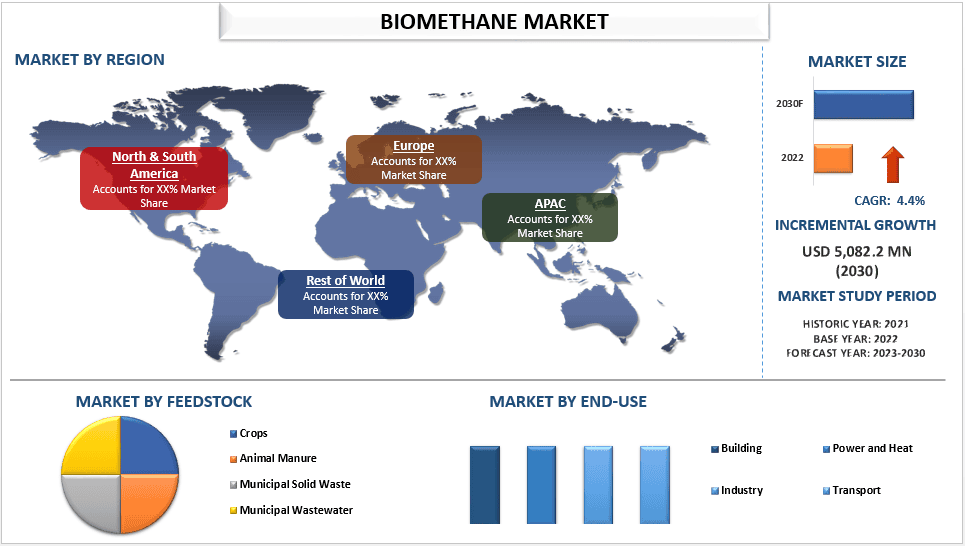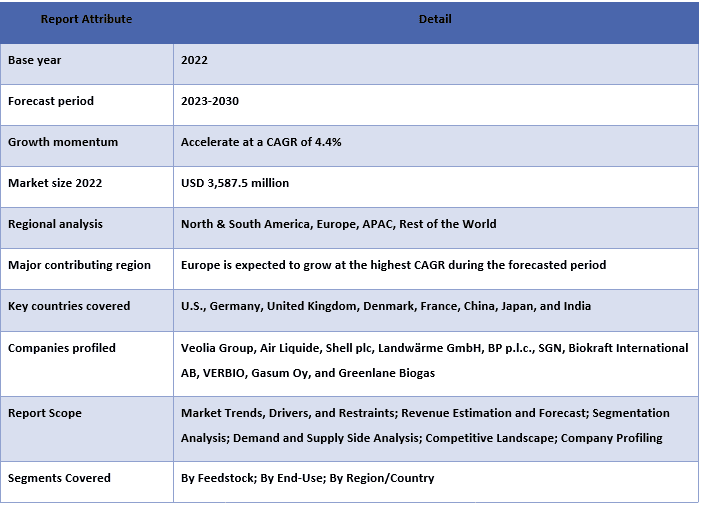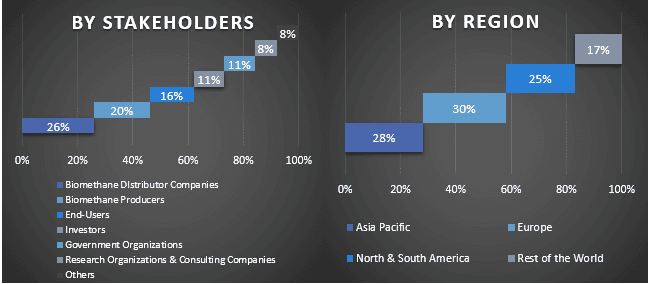Рынок биометана: текущий анализ и прогноз (2023-2030 гг.)
Акцент на сырье (сельскохозяйственные культуры, навоз, твердые бытовые отходы и городские сточные воды); конечное использование (строительство, энергетика и теплоснабжение, промышленность и транспорт); регион/страна.

Ожидается, что объем рынка биометана достигнет 5 082,2 млн долларов США в 2030 году, увеличиваясь в среднем на 4,4% в год. Биометан является экологически чистым топливом, поскольку оказывает незначительное влияние на глобальное потепление, так как метан удерживает тепло в атмосфере в 25 раз эффективнее, чем углекислый газ. Он также способствует достижению целей различных стран в области чистой энергии и помогает диверсифицировать их поставки газа, снижая зависимость от ископаемого топлива.
Хотя в настоящее время биометановая промышленность имеет очень небольшие масштабы, в ряде стран наблюдается растущий интерес к ней, особенно из-за ее потенциала использования существующей инфраструктуры для поставки чистой энергии широкому кругу конечных потребителей. В настоящее время на биометан приходится примерно 0,1% спроса на природный газ. Однако растет число правительственных мер, направленных на поддержку декарбонизации сети поставок и транспортировки природного газа.
Некоторые из основных игроков, работающих на рынке, включают Veolia Group, Air Liquide, Shell plc, Landwärme GmbH, BP p.l.c., SGN, Biokraft International AB, VERBIO, Gasum Oy и Greenlane Biogas. Этими игроками было предпринято несколько слияний и поглощений наряду с партнерствами, чтобы предоставлять клиентам высокотехнологичные и инновационные продукты/технологии.
Представленные в отчете сведения
«Среди сырья, категория биометана из животноводческого навоза будет расти со значительным среднегодовым темпом роста в течение прогнозируемого периода»
На основе сырья рынок биометана делится на культуры, животноводческий навоз, твердые бытовые отходы и сегменты муниципальных сточных вод. Сегмент животноводческого навоза приобрел большую долю на рынке биометана и, как ожидается, продемонстрирует существенный темп роста в течение прогнозируемого периода. Анаэробный реактор — это система для обработки навоза, а не для утилизации навоза. Крупный рогатый скот содержит много воды и клетчатки, что приводит к низкой урожайности биогаза и эффективности деградации, что препятствует расширению использования биогазовой технологии в сельском хозяйстве. Модернизация биогаза до биометана может удалить любой CO2 и другие загрязнения, присутствующие в биогазе. Биометан можно производить из широкого спектра сырья, включая навоз сельскохозяйственных животных, включая крупный рогатый скот, свиней, птицу и овец. Производство биометана из биогаза является растущей областью со значительным потенциалом для дальнейшего роста, хотя это в значительной степени зависит от силы и структуры политики, направленной на декарбонизацию газоснабжения в различных частях мира.
«Среди конечного использования, категория электроэнергии и тепла будет расти со значительным среднегодовым темпом роста в течение прогнозируемого периода»
На основе конечного использования рынок биометана делится на сегменты зданий, электроэнергии и тепла, промышленности и транспорта. Сегмент электроэнергии и тепла приобрел большую долю на рынке биометана и, как ожидается, продемонстрирует существенный темп роста в течение прогнозируемого периода. Биометан, также известный как «возобновляемый природный газ», можно использовать в различных энергетических секторах, включая электроэнергию и тепло. Большая часть биогаза, произведенного в мире, была использована для производства электроэнергии и тепла в 2018 году. Рентабельность производства биометана зависит от размера установки, входных субстратов и затрат на подключение к сети. Биогаз можно использовать непосредственно для производства электроэнергии и тепла, с примерно равным разделением между установками, производящими только электроэнергию, и установками когенерации.
«Европа будет расти с высоким среднегодовым темпом роста в ближайшие годы»
Европа приобрела самую высокую долю рынка биометана и, как ожидается, станет свидетелем значительного среднегодового темпа роста в прогнозируемый период. Европа является крупнейшим производителем биогаза на сегодняшний день. Германия является безусловно крупнейшим рынком и домом для трети мощностей биогазовых установок в Европе. Энергетические культуры были основным выбором сырья, которое лежало в основе роста биогазовой промышленности Германии, но в последнее время политика больше сместилась в сторону использования остатков сельскохозяйственных культур, последовательных культур, отходов животноводства и улавливания метана с полигонов. Другие страны, такие как Дания, Франция, Италия и Нидерланды, активно продвигали производство биогаза. Европа, как ведущий регион по производству биогаза, насчитывает около 20 000 биогазовых установок, большинство из которых расположены в Германии. Большинство из них построены для производства электроэнергии на месте и когенерации, и около 500 установок предназначены для модернизации биогаза. Кроме того, несколько стран Европы также разрабатывают газовую транспортную инфраструктуру; большая часть производства биометана в Швеции используется в транспортных средствах, что дает ей самую высокую долю использования биометана в транспортном спросе. Италия имеет хорошо развитый парк транспортных средств, работающих на природном газе, и расширяющуюся сеть заправок, а недавно ввела обязательства по смешиванию биометана.
Охват отчета о рынке биометана

Причины для покупки этого отчета:
- Исследование включает в себя анализ размеров рынка и прогнозирование, подтвержденный проверенными ключевыми экспертами отрасли.
- В отчете представлен краткий обзор общих показателей отрасли с первого взгляда.
- Отчет охватывает углубленный анализ видных игроков отрасли с основным акцентом на ключевые финансовые показатели бизнеса, продуктовые портфели, стратегии расширения и последние разработки.
- Подробное изучение драйверов, ограничений, ключевых тенденций и возможностей, преобладающих в отрасли.
- Исследование всесторонне охватывает рынок по различным сегментам.
- Глубокий региональный анализ отрасли.
Варианты настройки:
Глобальный рынок биометана может быть дополнительно настроен в соответствии с требованиями или любым другим сегментом рынка. Кроме того, UMI понимает, что у вас могут быть свои собственные бизнес-потребности, поэтому не стесняйтесь связаться с нами, чтобы получить отчет, который полностью соответствует вашим требованиям.
Содержание
Методология исследования для анализа рынка биометана (2023-2030 гг.)
Анализ исторического рынка, оценка текущего рынка и прогнозирование будущего рынка глобального рынка биометана были тремя основными шагами, предпринятыми для создания и анализа внедрения биометана в основных регионах мира. Было проведено исчерпывающее вторичное исследование для сбора исторических рыночных данных и оценки текущего размера рынка. Во-вторых, для подтверждения этих выводов было принято во внимание множество результатов и предположений. Кроме того, были проведены исчерпывающие первичные интервью с отраслевыми экспертами по всей цепочке создания стоимости глобального рынка биометана. После предположений и подтверждения рыночных данных посредством первичных интервью мы использовали подход "сверху вниз/снизу вверх" для прогнозирования общего размера рынка. После этого были приняты методы разбивки рынка и триангуляции данных для оценки и анализа размера рынка сегментов и подсегментов соответствующей отрасли. Подробная методология описана ниже:
Анализ исторического размера рынка
Шаг 1: Углубленное изучение вторичных источников:
Было проведено подробное вторичное исследование для получения исторических данных о размере рынка биометана из внутренних источников компании, таких как годовые отчеты и финансовые отчетности, презентации о деятельности, пресс-релизы и т.д., и внешних источников, включая журналы, новости и статьи, правительственные публикации, публикации конкурентов, отраслевые отчеты, сторонние базы данных и другие надежные публикации.
Шаг 2: Сегментация рынка:
После получения исторических данных о размере рынка биометана мы провели детальный вторичный анализ для сбора исторических рыночных данных и доли различных сегментов и подсегментов для основных регионов. Основные сегменты, включенные в отчет: сырье и конечное использование. Кроме того, был проведен анализ на уровне стран для оценки общего уровня внедрения моделей тестирования в этом регионе.
Шаг 3: Факторный анализ:
После получения исторических данных о размере рынка различных сегментов и подсегментов мы провели подробный факторный анализ для оценки текущего размера рынка биометана. Кроме того, мы провели факторный анализ с использованием зависимых и независимых переменных, таких как сырье и конечное использование рынка биометана. Был проведен тщательный анализ сценариев спроса и предложения с учетом ведущих партнерств, слияний и поглощений, расширения бизнеса и запуска продуктов в секторе рынка биометана по всему миру.
Оценка и прогноз текущего размера рынка
Определение текущего размера рынка: Основываясь на практически полезных выводах, полученных на основе вышеуказанных 3 шагов, мы определили текущий размер рынка, ключевых игроков на глобальном рынке биометана и доли рынка сегментов. Все необходимые процентные доли и разбивки рынка были определены с использованием вышеупомянутого вторичного подхода и проверены посредством первичных интервью.
Оценка и прогнозирование: Для оценки и прогнозирования рынка различным факторам были присвоены веса, включая драйверы и тенденции, ограничения и возможности, доступные для заинтересованных сторон. После анализа этих факторов были применены соответствующие методы прогнозирования, т.е. подход "сверху вниз/снизу вверх", для получения прогноза рынка на 2030 год для различных сегментов и подсегментов на основных рынках по всему миру. Методология исследования, принятая для оценки размера рынка, включает в себя:
- Размер рынка отрасли с точки зрения выручки (долл. США) и уровень внедрения биометана на основных рынках внутри страны
- Все процентные доли, разбивки и разбивки рыночных сегментов и подсегментов
- Ключевые игроки на мировом рынке биометана с точки зрения предлагаемых продуктов. Также стратегии роста, принятые этими игроками для конкуренции на быстрорастущем рынке
Подтверждение размера и доли рынка
Первичное исследование: Были проведены углубленные интервью с ключевыми лидерами мнений (KOL), включая руководителей высшего звена (CXO/вице-президенты, руководители отдела продаж, руководители отдела маркетинга, руководители отдела оперативной деятельности, региональные руководители, руководители стран и т.д.) в основных регионах. Затем были обобщены результаты первичных исследований и проведен статистический анализ для подтверждения заявленной гипотезы. Входные данные первичных исследований были объединены с результатами вторичных исследований, что превратило информацию в практически полезные выводы.
Разбивка первичных участников по различным регионам

Инжиниринг рынка
Для завершения общей оценки рынка и получения точных статистических данных для каждого сегмента и подсегмента глобального рынка биометана был использован метод триангуляции данных. Данные были разделены на несколько сегментов и подсегментов после изучения различных параметров и тенденций в областях сырья и конечного использования на глобальном рынке биометана.
Основная цель исследования глобального рынка биометана
В исследовании были точно определены текущие и будущие рыночные тенденции глобального рынка биометана. Инвесторы могут получить стратегические выводы, чтобы основывать свои решения для инвестиций на качественном и количественном анализе, проведенном в исследовании. Текущие и будущие рыночные тенденции определили общую привлекательность рынка на региональном уровне, предоставив промышленному участнику платформу для использования неиспользованного рынка, чтобы воспользоваться преимуществом первопроходца. Другие количественные цели исследований включают в себя:
- Анализ текущего и прогнозируемого размера рынка биометана в стоимостном выражении (долл. США). Также проанализируйте текущий и прогнозируемый размер рынка различных сегментов и подсегментов
- Сегменты в исследовании включают области сырья и конечного использования
- Определение и анализ нормативно-правовой базы для индустрии биометана
- Анализ цепочки создания стоимости с участием различных посредников, а также анализ поведения клиентов и конкурентов в отрасли
- Анализ текущего и прогнозируемого размера рынка биометана для основного региона
- Основные страны регионов, исследованные в отчете, включают Азиатско-Тихоокеанский регион, Европу, Северную Америку и остальной мир
- Профили компаний рынка биометана и стратегии роста, принятые участниками рынка для поддержания устойчивости на быстрорастущем рынке
- Углубленный анализ отрасли на региональном уровне
Часто задаваемые вопросы Часто задаваемые вопросы
В1: Каков текущий размер рынка и потенциал роста глобального рынка биометана?
Q2: Каковы движущие факторы роста глобального рынка биометана?
Q3: Какой сегмент имеет наибольшую долю на мировом рынке биометана по сырьевым ресурсам?
Q4: Каковы новые технологии и тенденции на мировом рынке биометана?
Q5: Какой регион будет доминировать на глобальном рынке биометана?
Q6: Кто является ключевыми игроками, работающими на глобальном рынке биометана?
Связанные Отчеты
Клиенты, купившие этот товар, также купили










